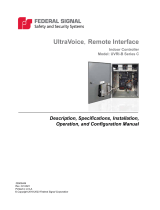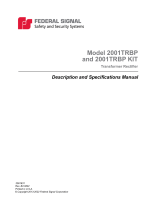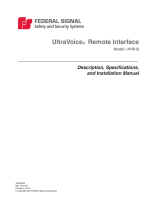
8
Informer Series C Overview
Informer-IP Series C
Federal Signal www.fedsig.com
Informer Series C Overview
The Federal Signal Informer series IP products incorporate industry-standard Web, SIP
phone, and Modbus® PLC interfaces to simplify integration with existing systems. The
products can be purchased as part of a pre-integrated Commander® IP solution with a
touch screen HMI that can simplify configuring, controlling, and monitoring thousands
of unique alert and notification scenarios. Commander® includes options for digital
and analog RF, Cellular, Satellite, and CommanderOne® cloud services for messaging
and automated NOAA Weather alerting. CommanderOne® iOS and Android® mobile
applications keep you connected with controlling, monitoring, and messaging wherever
you go.
Store over 4000 WAV files containing tones, music, or voice messages on a removable
SD card in the Informers. The WAV files can be configured to play when a local input
is activated or remotely using the SIP, Modbus®, and Commander® interfaces. The
Informer indoor and outdoor speakers include four digital inputs. These inputs can be
configured to directly activate the speaker to play a string of 1-19 WAV files and control
integrated relay output(s) or initiate predefined macros to activate multiple speakers
when the Commander® application is purchased. The inputs can be remotely monitored
and configured to activate other speakers when integrated with the Commander® HMI.
The Informers are remotely configurable and can obtain software updates through the
speaker’s web page and the optional Commander® software application.
Automatic Volume Level Control
The Informer speakers can be configured to automatically adjust the speaker’s output
level when the local ambient noise level changes. Configure the maximum level and
ambient attenuation settings on the Informer’s web page.
NOTE: Automatic volume control is not available with the I-IP2 and I-IPSIU products.
Digital Inputs
The Informers have digital inputs that can be activated using a dry contact closure.
Configure the inputs from the Informer’s web page. See “2. Configuring the RTU Settings”
on page 21. Each input can be configured to play 1-19 WAV files when the input is
activated. The WAV files to be played are entered by index number in a comma-separated
list, for example, 1,2,6. Relay outputs can be selected to close when the input is active and
remains closed until the associated WAV file(s) have finished playing.
The inputs can be configured for normally open or normally closed contacts and assigned
a priority level of 1 to n (n = number of inputs available in the product). The inputs can be
configured for momentary or continuous operation, or they can be disabled. Momentary
inputs will play the associated WAV file one time when the state changes to active.
Continuous configured inputs will continue to play the associated WAV files and open
or close associated relay output(s) as long as the input is active. If multiple continuous
inputs are active, the WAV files and relay outputs associated with each input will activate
in sequence. Lower priority inputs are ignored while higher priority inputs are active.
If an equal or greater priority momentary input is activated while a continuous input is
active, the momentary input will interrupt the WAV file and relay controls associated with
the continuous input. The continuous input(s) will resume control when the WAV file(s)
associated with the momentary input finish playing. Equal or higher priority momentary
inputs will override other active momentary controls.





























